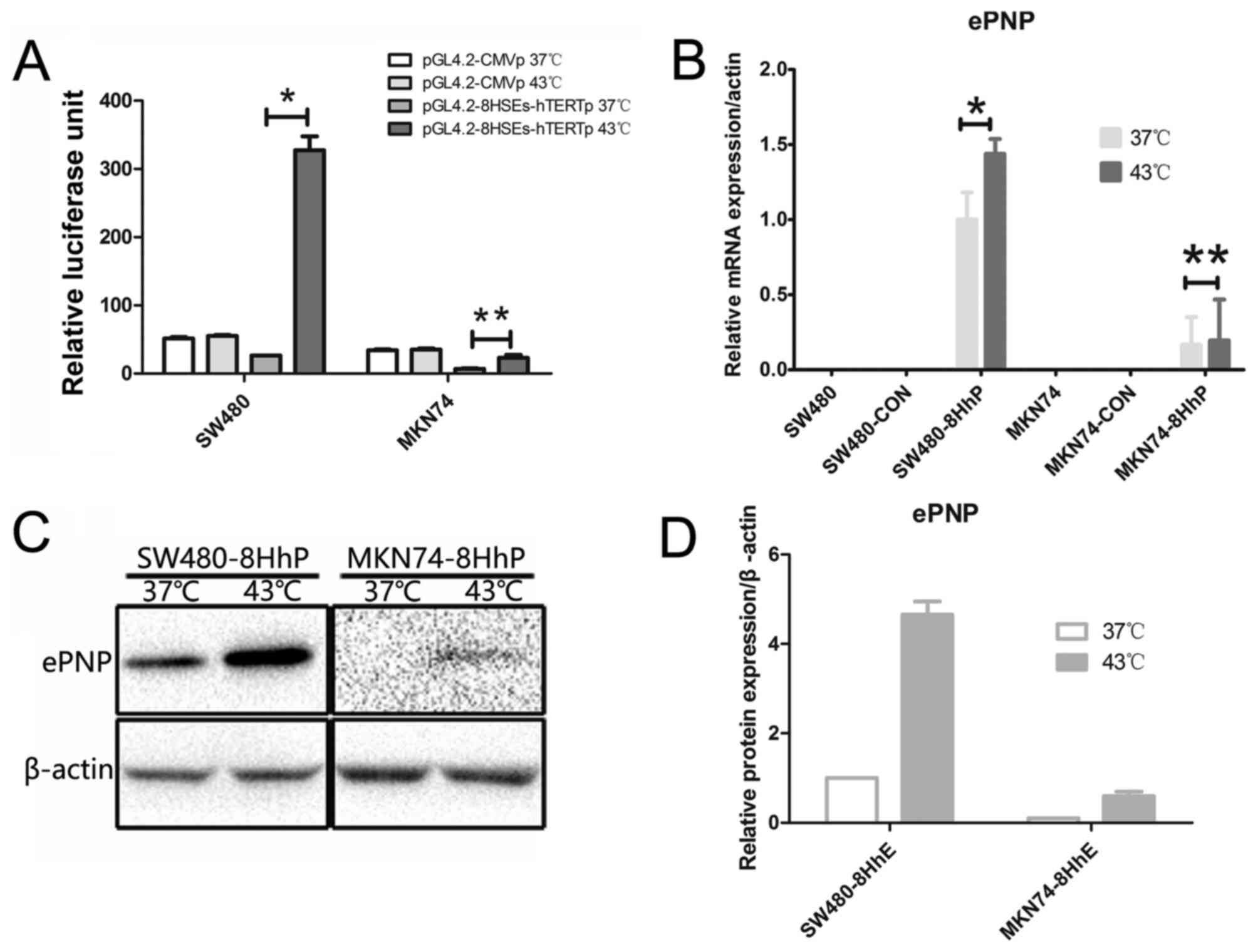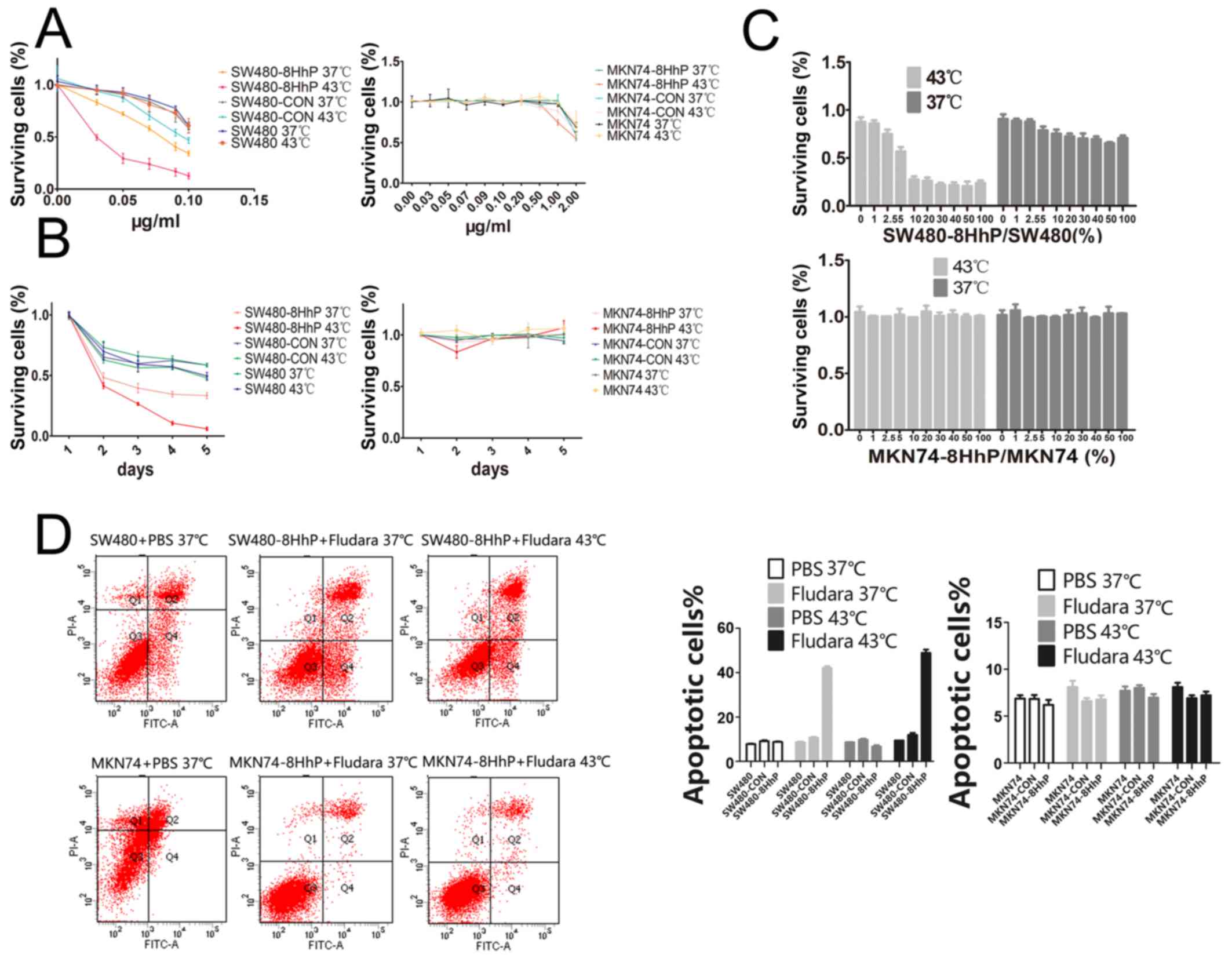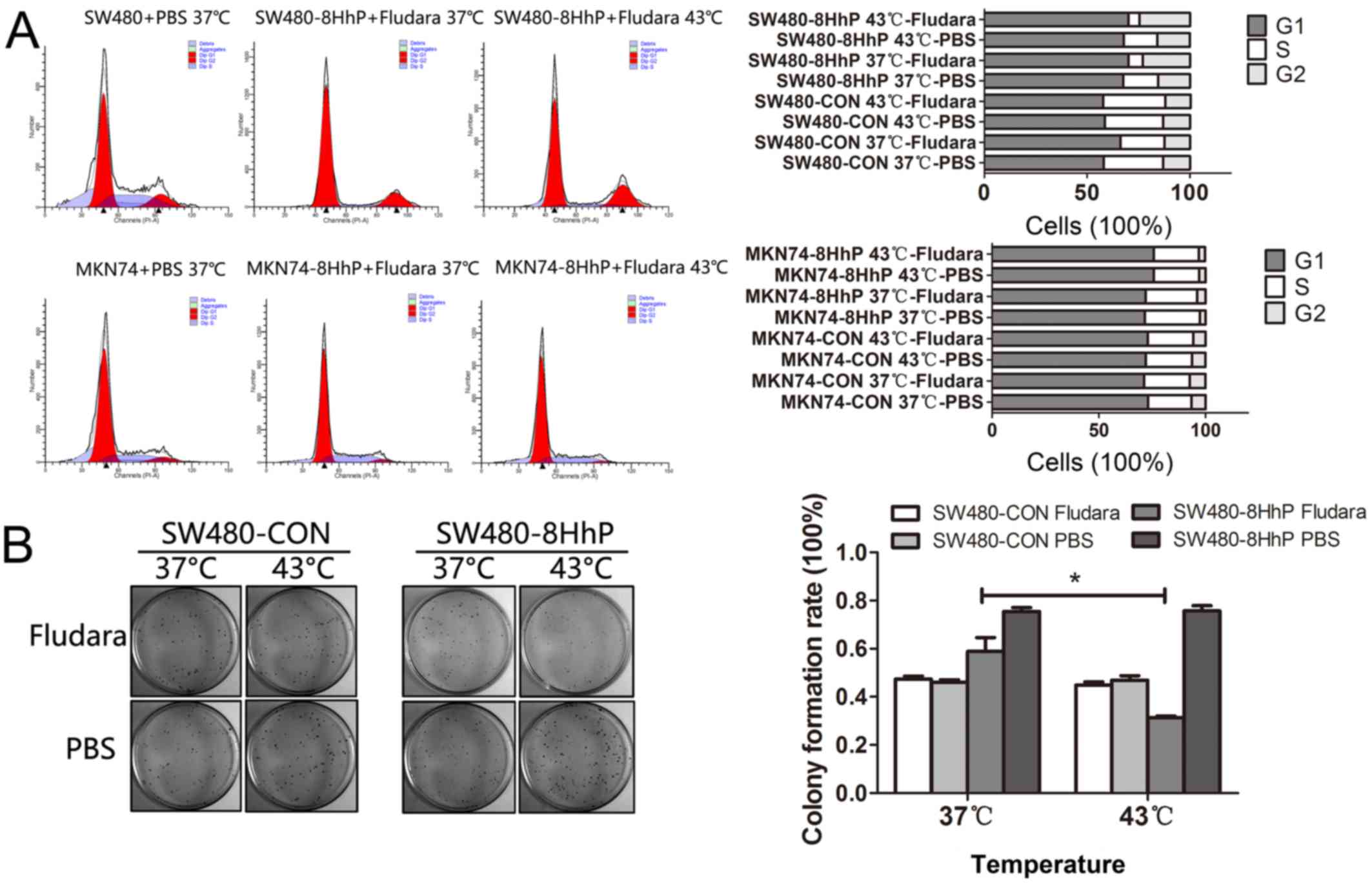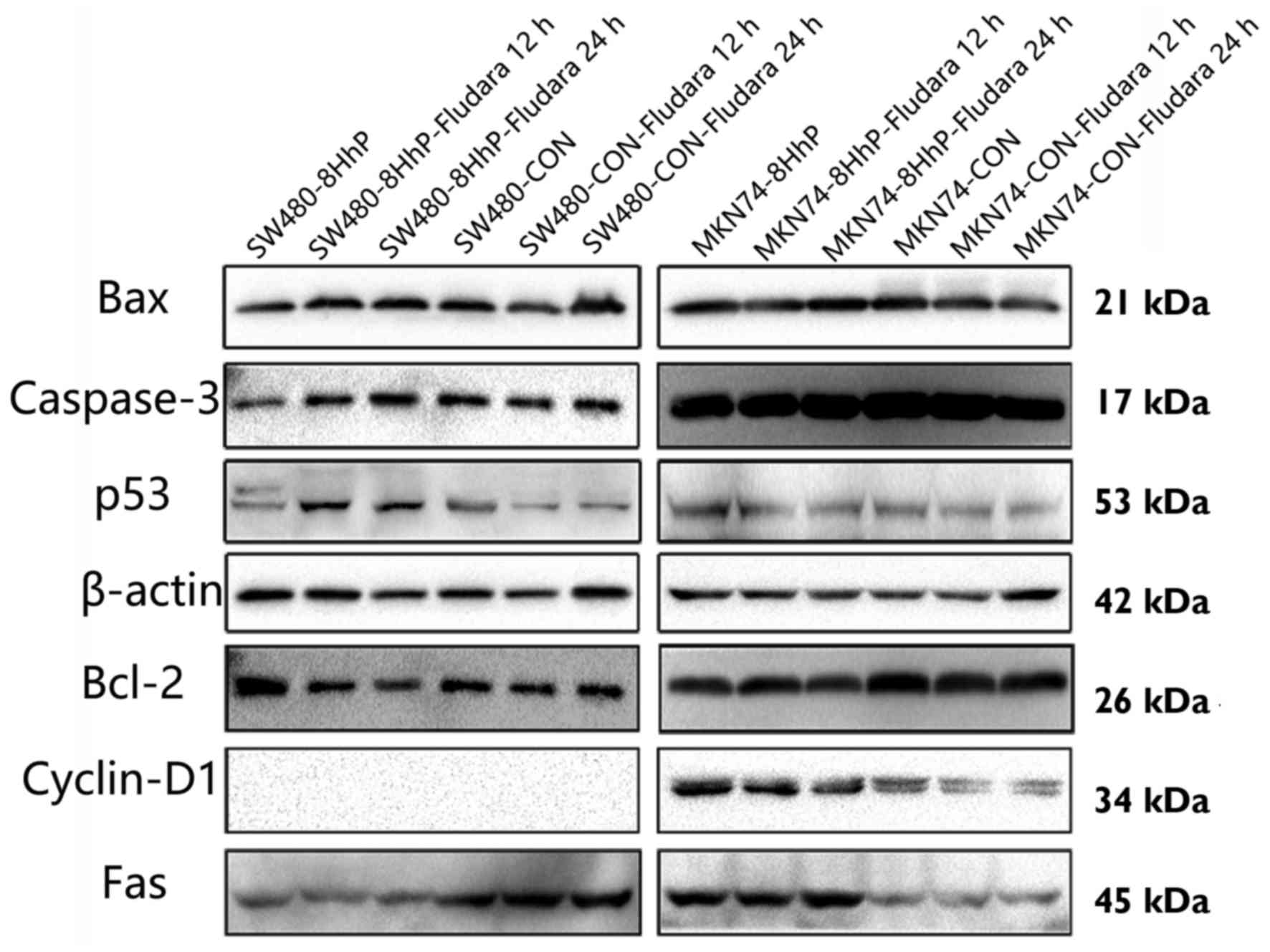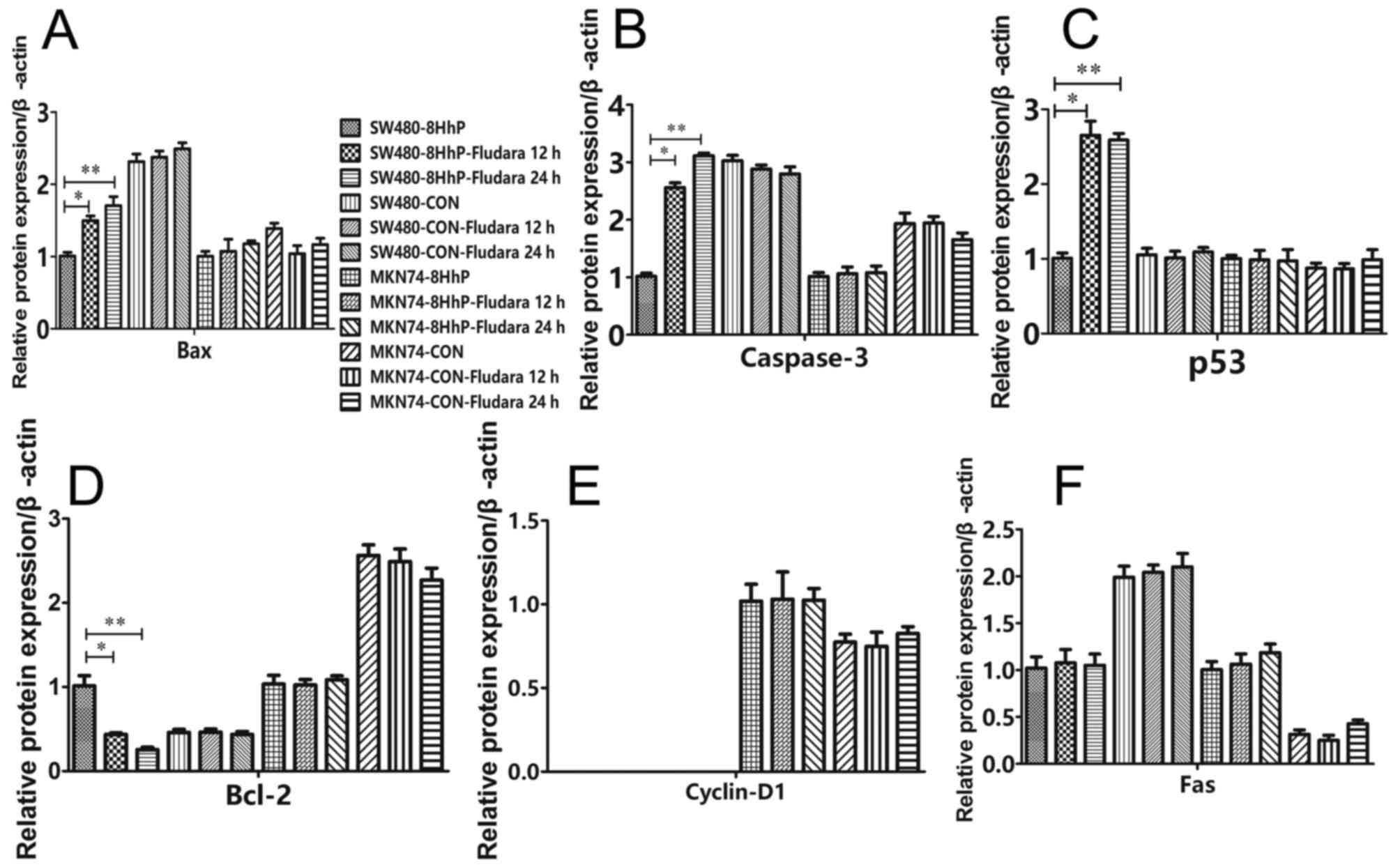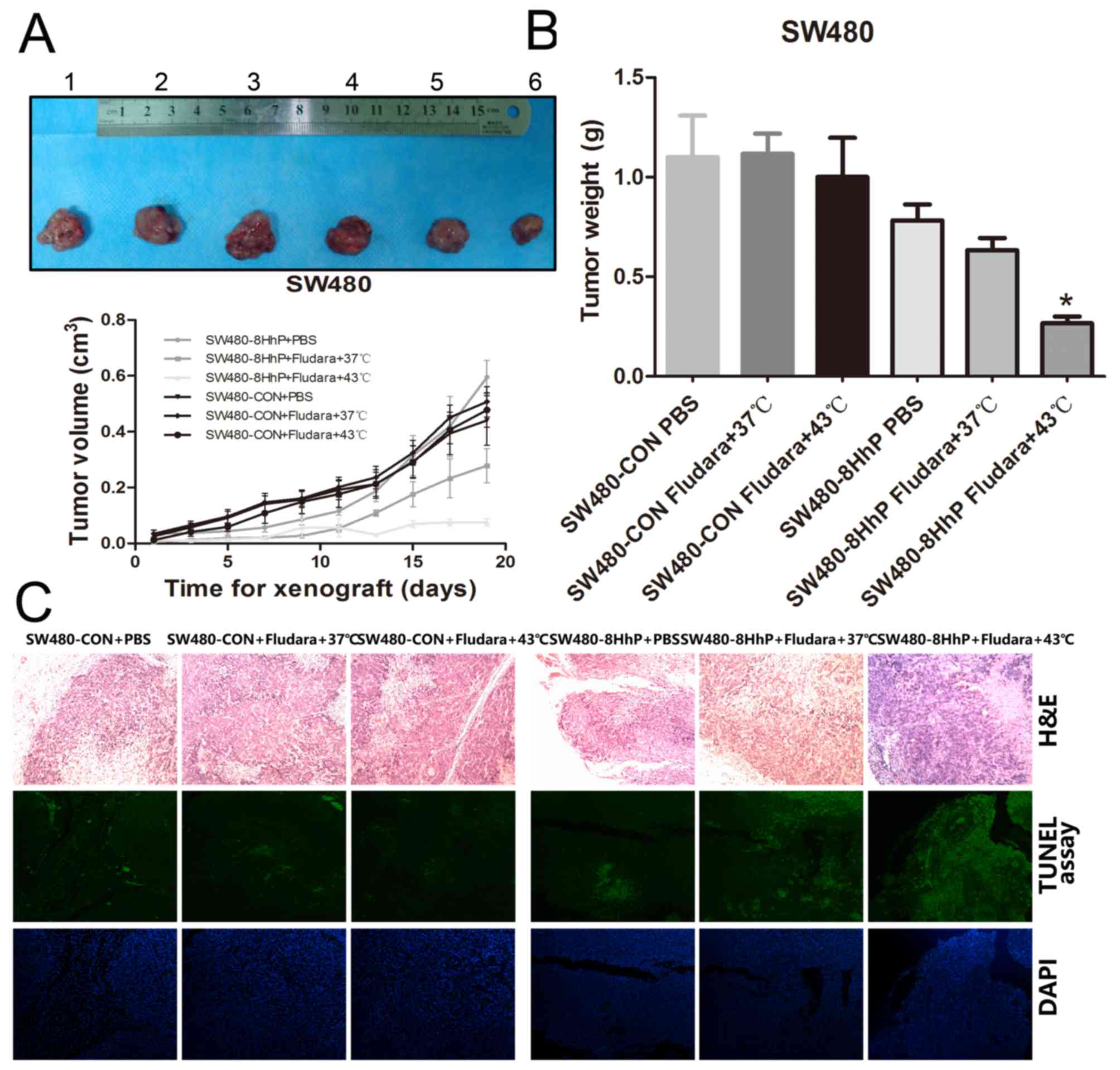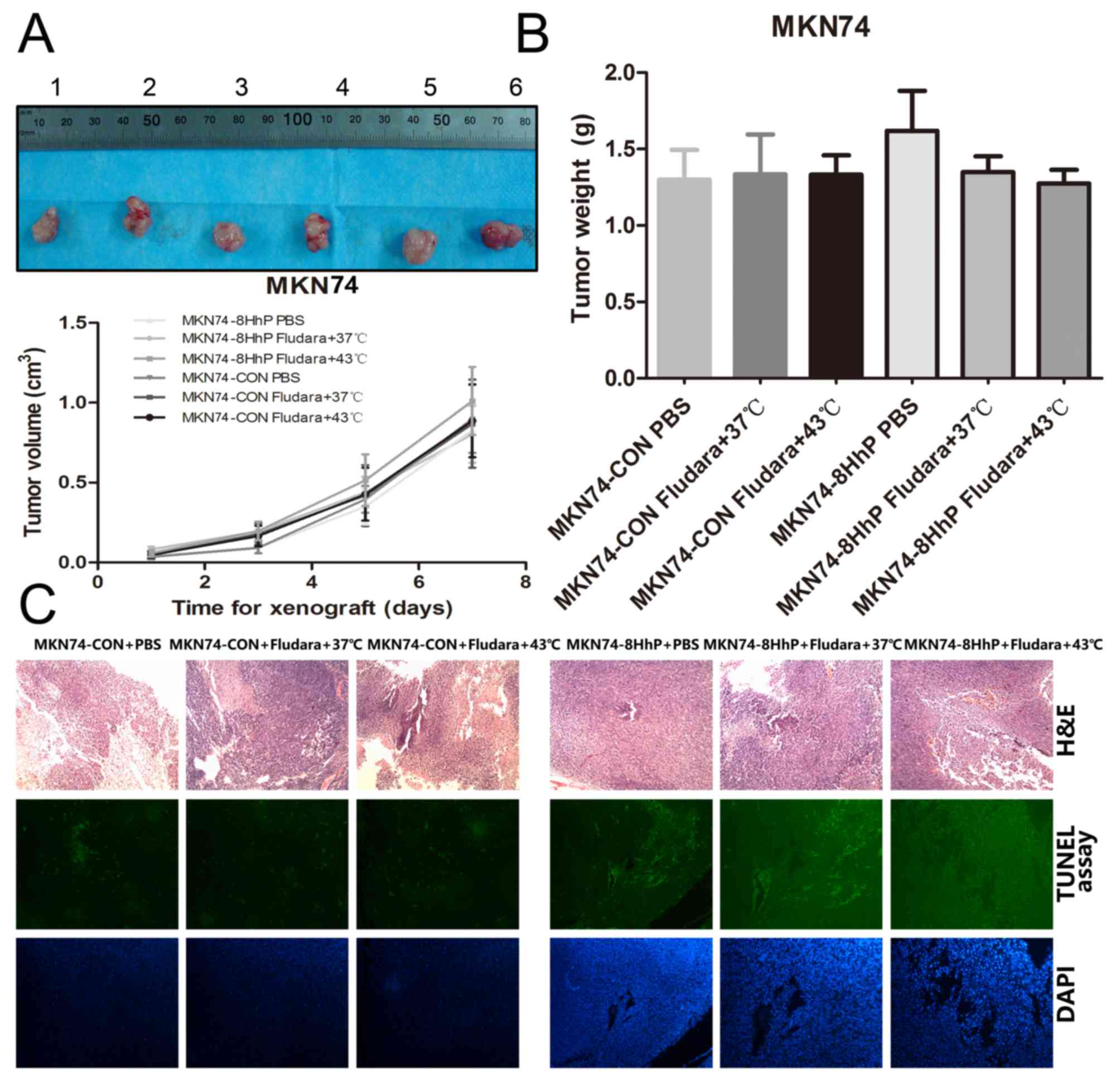Antitumor effects of a dual-specific lentiviral vector carrying the Escherichia coli purine nucleoside phosphorylase gene
- Authors:
- Published online on: April 4, 2017 https://doi.org/10.3892/ijo.2017.3949
- Pages: 1612-1622
-
Copyright: © Wang et al. This is an open access article distributed under the terms of Creative Commons Attribution License.
Abstract
Introduction
The Escherichia coli purine nucleoside phosphorylase/fludarabine (ePNP/Fludara) suicide system, originally described by Sorscher et al (1), has been demonstrated to have powerful killing and bystander effects (2). Differing from human or mammalian PNP, this bacterial PNP enzyme converts the low-toxic prodrug Fludara into a very toxic metabolite, 2-fluoroadenine (F-Ade). F-Ade impairs DNA, RNA and protein synthesis (3), killing both dividing and non-dividing cells. However, several drawbacks to PNP/Fludara suicide system remain to be resolved, including the side-effects and low efficiency of ePNP gene expression.
Hyperthermia, an inducible antitumor treatment, has gained acceptance for cancer therapy in breast and colorectal carcinomas as well as malignant melanomas (4–6). Recent studies have shown that hyperthermia not only sensitizes tumor cells to radiation and chemotherapy, but also activates HSP70 expression in some cells. This makes the combination of hyperthermia and gene therapy possible. Furthermore, hyperthermia can augment the effects of therapeutic genes in a controlled range (7). Hyperthermia-induced HSP70 activation is regulated at the transcriptional level (8) and depends on heat shock elements (HSEs), which are short sequences in the HSP70 promoter that are essential for heat inducibility. The introduction of HSEs into a gene transfer vector makes it possible to provide special control over exogenous gene expression in a locally heated tumor (8).
The human telomerase reverse transcriptase (hTERT) promoter has been widely used to drive the specific expression of therapeutic genes for cancer treatment. The hTERT promoter is significantly weaker than many commonly used viral promoters, such as the cytomegalovirus (CMV) early promoter and the simian virus 40 (SV40) early promoter (9). This limitation caused us to hypothesize that the combination of heat shock elements (HSEs) with the hTERT promoter in a recombinant lentiviral vector may significantly increase the transcriptional activity of the hTERT promoter, improving the efficiency of ePNP gene expression in a locally heated tumor.
Therefore, we designed and constructed a recombinant lentiviral vector carrying the ePNP gene under the control of the 8HSEs-hTERT promoter, which ensured targeted and powerful gene expression in tumor cells. We expect that administration of this recombinant lentiviral vector together with the prodrug Fludara could provide a new strategy for clinical therapy of solid tumors together with hyperthermia.
Materials and methods
Reagents
Fludarabine phosphate (Fludara) was obtained from Sigma-Aldrich (St. Louis, MO, USA) and dissolved in phosphate-buffered saline (PBS). Rabbit monoclonal antibodies specific for Bax, Bcl-2, caspase-3, p53, Fas, cyclin D1 and β-actin were obtained from Epitomics (Burlingame, CA, USA); rabbit monoclonal antibodies specific for 3FALG were obtained from Sigma-Aldrich. TurboFect™ transfection reagent was acquired from Thermo Fisher Scientific (Waltham, MA, USA), and Dual-Glo Luciferase assay system from Promega (Madison, WI, USA).
Cell culture and in vitro hyperthermia
Human colorectal cancer SW480 and gastric cancer MKN74 cells were obtained from Shanghai Institute of Cell Biology, Chinese Academy of Sciences (Shanghai, China). SW480 and MKN74 cells were cultured in RPMI-1640 supplemented with 10% fetal bovine serum (FBS), 100 IU/ml penicillin, 100 mg/ml streptomycin and 2 mM L-glutamine. Cells were grown at 37°C in a humidified atmosphere containing 5% CO2. Cells were seeded into cell culture dishes and incubated at 37°C for 24 h. Afterwards, cells were transferred to a cell culture incubator that was pre-adjusted to 43°C for 1 h every 48 h (data not shown) (10). After incubation for the desired time, cells were transferred back to the 37°C incubator and incubated for several hours to recover from the heat treatment.
Construction of plasmid vectors
Preparation of plasmids was accomplished using the Omega plasmid midi kit (Omega, Norcross, GA, USA). The 295-bp promoter region (11) of human TERT [GenBank accession no. AN097365] was amplified by PCR from human genomic DNA, using the following primer pairs: TERT promoter (forward, 5′-CTAGCTAGCCACAGACGCCCAGGACCGCGCTTC-3′; reverse, 5′-CCC AAGCTTCCACGTGCGCCCACGTGCGCCCAC-3′. The 295-bp fragment was inserted into pGL4.2 (Promega) upstream of the luciferase reporter gene and verified by DNA sequencing to generate pGL4.2-hTERTp. Eight heat shock elements (8HSEs) with optimized AGAACGTTCTAGAAC sequences (10,12) alternately separated by 5 bp were generated by oligonucleotide ligation. The 8HSEs fragments were inserted upstream of the luciferase reporter in pGL4.2-hTERTp to generate pGL4.2-8HSEs-hTERTp.
The 588-bp CMV early promoter was amplified by PCR from pLVX-EGFP-3FLAG (GeneChem, Shanghai, China), using the following primer pairs: forward, 5′-CGCCTCGAGCCGCCTGGCTGACCGCCCA-3′; reverse, 5′-GCCAGATCTGCCATGGTTCGAATTCAAAT-3′. The amplified 588-bp fragment was cloned into pGL-4.2 to generate pGL4.2-CMVp.
Dual luciferase assay
SW480 and MKN74 cells were seeded 5,000 cells per well into each well of a 96-well plate. The next day, cells were transfected with 150 ng luciferase reporter plasmid (pGL4.2-8HSEs-hTERTp or pGL4.2-CMVp) and 30 ng of pGL-4.74 (containing the TK promoter; Promega) as an internal control using the TurboFect™ Transfection reagent (Thermo Fisher Scientific) according to the manufacturer's instructions. After 10-h transfection, the mixture was replaced with fresh medium. After 48 h, cells were subjected to heat treatments. Luciferase assays were performed 6 h later using the Dual-Glo Luciferase assay system (Promega). Briefly, 100 μl of Dual-Glo Luciferase assay reagent was added to each well, followed by the addition of 100 μl Dual-Glo Stop & Glo reagent. Renilla luminescence was normalized to the internal control vector pGL-4.74 luminescence. Promoter activities were measured as relative luminescence units (RLU) where the value of the firefly luciferase luminescence of pGL-4.2 was divided by the Renilla luciferase pGL-4.74 from the same well.
Establishment of stable lentivirus-transfected cell lines
Two recombinant lentiviruses pLVX-8HSEs-hTERTp-ePNP-3FLAG (8HhP) and a negative control pLVX-Ubi-3FLAG (CON) containing the ubiquitin promoter were purchased from GeneChem. The recombinant lentiviral vector (pLVX-8HSEs-hTERTp-ePNP-3FLAG) including the hTERT promoter modified by the artificial 8HSEs, the ePNP gene and three consecutive FLAG sequences was constructed using conventional recombinant techniques. SW480 and MKN74 cells were transduced with the 8HhP and CON lentiviruses following standard techniques. After 72 h, lentivirus-carrying clones were selected for 15 days in medium containing 1 mg/ml puromycin (Life Technologies, Grand Island, NY, USA).
Quantitative reverse transcription polymerase chain reaction (qRT-PCR)
SW480, MKN74 and the stably transfected SW480-8HhP, SW480-CON, MKN74-8HhP and MKN74-CON cells were subjected to an RNA Fast 200 kit (Pioneer Biotech, Xi'an, China) to isolate total RNA according to the manufacturer's instructions. cDNA was synthesized from 1 μg of DNase I-treated total RNAs with PrimeScript™ RT Master Mix (Takara, Dalian, China) according to the manufacturer's instructions. An aliquot (1 μl) of the cDNA was then subjected to qRT-PCR analysis of ePNP mRNA using SYBR® Premix Ex Taq™ II (Takara). The primers were as follows: ePNP (product: 64 bp) forward, 5′-TGGGTCACGGTATGGGTATC-3′; reverse, 5′-CCGAAATCGGTGATCAGTTC-3′. β-actin (product: 151 bp) forward, 5′-CTTAGCACCCCTGGCCAAG-3′; reverse, 5′-GATGTTCTGGAGAGCCCCG-3′. The ePNP and β-actin qPCR reaction mixture was denatured at 94°C for 3 min followed by 40 cycles of 94°C for 30 sec, 57°C for 30 sec, and 72°C for 30 sec. All reactions were performed in triplicate and the relative ePNP mRNA level in each cell line was calculated by the 2−ΔΔCt method, where ACt = Ct (ePNP) - Ct (β-actin).
Protein extraction and western blots
Cells treated with or without Fludara were lysed on ice with NP-40 buffer containing 40 mM Tris-HCl (pH 6.9), 2 mM ethylenediaminetetraacetic acid (EDTA, pH 8.0), 100 mM sodium fluoride, 150 mM NaCl, 10 mM sodium pyrophosphate, 1% Tergitol type NP-40, 2 mM sodium orthovanadate, 1% Triton X-100, 1.0 mM phenylmethanesulfonyl fluoride (PMSF), and 1X protease inhibitor mini-tablet (Roche, Basel, Switzerland). Lysates were then clarified by centrifugation at 12,000 × g for 10 min at 4°C. Protein concentration was estimated using the Pierce Protein Estimation system (Thermo Fisher Scientific) according to the manufacturer's protocol. Next, equal amounts (30 μg) of protein were heated at 95°C for 5 min in 5X Laemmli sample buffer, separated on a 10% SDS-PAGE gel and transferred onto polyvinylidene difluoride (PVDF) membranes by the wet transfer method. Non-specific binding was blocked for 1 h at 37°C using 10% fat-free milk in TBS containing 0.1% Tween-20. The membranes were blotted with anti-Bax, Bcl-2, caspase-3, p53, Fas, cyclin D1, β-actin or anti-3FALG primary antibodies at a dilution of 1:2,000. After washing three times with TBST, horseradish peroxidase-conjugated secondary antibodies (1:5,000 dilution; Proteintech, Chicago, IL, USA) were added at 27°C for 1 h. Immunoreactive bands were visualized using SuperSignal West Femto Maximum Sensitivity Substrate (Thermo Fisher Scientific) and exposed using the ChemiDoc XRS+ (Bio-Rad, Hercules, CA, USA).
Cell viability assay
Cell viability was detected using the cell counting kit-8 (CCK-8, Dojindo Molecular Technologies, Inc., Kumamoto, Japan). Briefly, 2,000 parental and stably transduced cells were inoculated into 96-well plates in a final volume of 200 μl growth medium. The hyperthermia group was treated at 43°C after 24 h. After treatment and incubation, each plate was subjected to the CCK-8 assay by adding 10 μl of CCK-8 solution to each well, and the plate was further incubated for 2 h at 37°C. The absorbance at 450 nm was measured with an EnSpire™ Multilabel Reader 2300 (Perkin-Elmer Inc., Waltham, MA, USA). The relative cellular survival rate was calculated using the following formula: (Asample − Ablank)/(Acontrol − Ablank) × 100% (13).
Flow cytometric apoptosis and cell cycle distribution assays
SW480, SW480-8HhP, SW480-CON, MKN74, MKN74-8HhP and MKN74-CON cells were seeded into 6-well plates and the hyperthermia group was treated at 43°C for 1 h every 48 h. For apoptotic analysis, apoptosis detection kit (Becton-Dickinson, Franklin Lakes, NJ, USA) was used to analyze apoptosis rates according to the manufacturer's instructions. For cell cycle analysis, cells growing in logarithmic phase were fixed with 75% ethanol for 24 h at −20°C, incubated with RNase A and Triton X-100 at 37°C for 30 min, and then incubated with propidium iodide at room temperature for 30 min. Cells were examined by flow cytometry, and CellQuest software (Becton-Dickinson) was used to conduct data acquisition and analysis.
Colony formation assay
SW480, SW480-8HhP, SW480-CON, MKN74, MKN74-8HhP and MKN74-CON cells (200 cells/well) were suspended in 2 ml media and seeded into 6-well plates. The hyperthermia group was also treated at 43°C for 1 h every 48 h, after treatment with or without Fludara, cells were fixed and stained with 1% crystal violet and cell colonies were counted under an inverted microscope. Statistical comparison was conducted using Student's t-test.
In vivo gene expression and analysis of antitumor effects
BALB/c nude mice were used according to the guidelines for administration to lab animals, issued by the Ministry of Science and Technology (Beijing, China). Tumors were established by subcutaneous inoculation with SW480 and MKN74 cells (100 μl containing 1×107 cells). Tumor volume was calculated using the empirical formula V = 0.52 × [(shortest diameter)2 × (longest diameter)]. When the tumor volume reached 100 mm3, tumor-bearing mice were randomly divided into six groups of 6 mice each: pLVX-Ubi-3FALG+PBS (SW480-CON+PBS), pLVX-Ubi-3FALG+Fludara+37°C (SW480-CoN+Fludara+37°C), pLVX-Ubi-3FALG+Fludara +43°C (SW480-CON+Fludara+43°C), pLVX-8HSEs-hTERTp-ePNP-3FALG+PBS (SW480-8HhP+PBS), pLVX-8HS Es-hTERTp-ePNP-3FALG+Fludara+37°C (SW480-8HhP+Fludara+37°C) and pLVX-8HSEs-hTERTp-ePNP-3FALG+ Fludara+43°C (SW480-8HhP+Fludara+43°C). The mice in each group were intratumorally administered 100 μl serum-free medium containing 1×108 pfu pLVX-Ubi-3FALG or pLVX-8HSEs-hTERTp-ePNP-3FALG. Three days later, lentivirus administration was repeated. Fludara (10 mg/kg) dissolved in 0.5 ml PBS was injected intraperitoneally three times daily for three consecutive days, beginning 48 h after the administration of recombinant lentivirus. This schedule was counted as a single course and three consecutive courses were administered (14). On the 11th and 13th day post-inoculation, mice were placed in a 43°C water bath for 1 h. The feet of the mice were tied to four nails on a board to ensure the transplanted tumors were immersed in the water bath (10). Tumor size and growth were monitored and measured using a caliper at regular intervals. Mice were sacrificed two weeks after the second virus injection and xenograft tumors were harvested, measured and photographed. Six mice in each group were sacrificed and the tumor specimens were subjected to histopathological analysis and TUNEL staining.
TUNEL assay
Paraffin-embedded tissue slides were prepared from the xenograft tumors. TUNEL staining was detected by the DeadEnd™ Fluorometric TUNEL system (Promega) according to the manufacturer's instructions. Cells were fixed and permeabilized with PBS containing 4% paraformaldehyde and 0.25% Triton X-100. Fluorescence was measured after incubation with FITC-labeled TUNEL. After TUNEL staining, the specimens were immersed with a DAPI solution (Sigma-Aldrich) to stain nuclei. Fluorescence staining was viewed by laser scanning confocal microscopy (FV300, Olympus, Tokyo, Japan) (15).
Statistical analysis
Results are shown as means ± standard error. Differences were evaluated with unpaired two-tailed Student's t-tests with unequal variance for multiple comparisons using the SPSS software version 19.0 (SPSS Inc., Chicago, IL, USA). P<0.05 was considered statistically significant. All experiments were independently repeated at least three times.
Results
Hyperthermia inducibility of the synthetic 8HSEs-hTERT promoter
To determine the hyperthermia inducibility of the synthetic 8HSEs-hTERT promoter after heat treatment, we transfected SW480 and MKN74 with pGL4.2-8HSEs-hTERTp or pGL4.2-CMVp. Transfected cells were incubated at either 43°C or 37°C for 1 h and the resultant luciferase activity was measured. Treatment at 43°C for 1 h significantly increased the luciferase activity of SW480 but not MKN74 cells (P<0.05 and P=0.219, respectively, Fig. 1A). Contrastingly, 43°C treatment resulted in no apparent differences in pGL4.2-CMVp luciferase activity among these cell lines. Moreover, after the 43°C treatment, the 8HSEs-hTERT promoter luciferase activity was significantly higher than the CMV promoter. These results demonstrated that hyperthermia could significantly enhance the transcriptional activity of the 8HSEs-hTERT promoter in SW480 cells, which endogenously express high hTERT levels. These data suggested that the 8HSEs-hTERTp promoter might be more efficient and specific than the CMV promoter for tumor targeting with hyperthermia.
Overexpression of ePNP in tumor cells using an 8HSEs-hTERTp-driven expression vector
We tested ePNP expression in hTERT-high expressing SW480 cells and hTERT-negative MKN74 cells (10) using an 8HSEs-hTERTp-driven expression vector at 37°C or 43°C. ePNP expression was confirmed by qRT-PCR and western blotting (Fig. 1B and C) in SW480-8HhP and MKN74-8HhP cells. SW480-8HhP cells showed very high levels of ePNP mRNA at 43°C or 37°C, but MKN74-8HhP only showed low levels of ePNP mRNA at 43°C or 37°C. Similarly, ePNP protein levels were significantly increased in SW480-8HhP cells under heat (Fig. 1D). However, ePNP protein levels were very low at 43°C in MKN74-8HhP cells, and almost absent at 37°C (Fig. 1C and D). As a heterologous gene, ePNP protein and mRNA were negative in SW480, MKN74, SW480-CON and MKN74-CON cells at 43°C or 37°C. These data indicated that both ePNP mRNA and protein were expressed in hTERT-high expressing SW480-8HhP cells, especially following heat application.
Sensitivity of infected cells to Fludara
To test whether ePNP could sensitize cancer cells to Fludara, we tested the proliferation of the different cell lines using the CCK-8 method to calculate IC50 values for each line, which was calculated as the drug concentration that inhibited growth by 50%. When incubated with different concentrations of Fludara (ranging from 0 to 2 μg/ml), parental, CON- and 8HhP-infected cells were resistant at 37°C. In contrast, SW480-8HhP cells were susceptible to Fludara at 43°C (IC50=0.02924), lower than SW480-8HhP cells at 37°C (IC50=0.07618), SW480 and SW480-CON at 37°C or 43°C (Fig. 2A). Conversely, hTERT-negative MKN74 cells showed a higher IC50 at 37°C or 43°C (Fig. 2A). At a concentration of 0.05 μg/ml Fludara, the sensitivity of the infected SW480 cells was time-dependent (Fig. 2B). The data showed that hyperthermia significantly reduced SW480-8HhP cell viability compared with either SW480 or SW480-CON cells, under both normal and heated conditions. However, this result was not replicated in MKN74-8HhP cells (Fig. 2B), because MKN74 cells do not express hTERT, and thus, the lentiviral vector did not induce ePNP expression in these cells (Fig. 2B). These results indicated that ePNP sensitized cancer cells to Fludara only in hTERT-high expressing SW480-8HhP cells, especially under heated conditions.
High level of bystander effect to Fludara
In the absence of ePNP-positive cells, the growth of parental cells was not affected even when the concentration of Fludara was 0.1 μg/ml. At a concentration of 0.05 μg/ml Fludara, a significant bystander effect could be detected, even at a very low proportion (5%, Fig. 2C) of ePNP-positive SW480-8HhP cells at 43°C. We detected a weaker bystander effect at the same proportion of ePNP-positive SW480-8HhP cells at 37°C. Furthermore, no obvious bystander effect was detected in MKN74-CON and MKN74-8HhP cells at 43°C or 37°C. These results indicated that a significant bystander effect was found in SW480-8HhP cells under heated conditions (Fig. 2C).
Effects of Fludara on SW480 apoptosis
To further elaborate the causes of cell growth inhibition, we detected apoptosis rates by flow cytometry. The results showed that 0.05 μg/ml Fludara treatment increased the rate of spontaneous apoptosis in the infected cells compared with control cells (Fig. 2D) in hTERT-high expressing SW480 cells, but not in MKN74 cells. The greatest increase in the number of apoptotic cells was in SW480-8HhP, and the ratio was 48.9% at 43°C and 42.1% at 37°C. These results indicated that the suicide system ePNP/Fludara inhibited cell proliferation by causing apoptosis, and the 8HSEs-hTERT promoter could enhance the effect only in hTERT-high expressing cells under heated conditions.
Effects of Fludara on SW480 cell cycle profiles
To explore the mechanism whereby the suicide system ePNP/Fludara inhibited cell proliferation, we studied the effect on the cell cycle. The targeted cells were treated with 0.05 μg/ml Fludara at 43°C or 37°C, and cellular DNA content was measured by flow cytometry. The data obtained from these studies demonstrated that ePNP/Fludara induces a G2 cell cycle arrest only in SW480-8HhP cells (Fig. 3A). At 72 h, flow cytometric analysis of SW480-8HhP cells showed an ~2-fold increase in the percentage of cells in G2-M phase (22.89%) compared with cells infected with CON vector (12.32%; Fig. 3A) under normal conditions. The addition of hyperthermia produced an additional increase in G2-M cells to 24.5% in SW480-8HhP cells. Conversely, few differences were observed between MKN74-CON and MKN74-8HhP cells at 43°C or 37°C. These results indicated that the suicide system ePNP/Fludara inhibited cell proliferation by causing a G2 cell cycle arrest, and the 8HSEs-hTERT promoter could enhance the effect only in hTERT-high expressing cells under heated conditions.
Effects of Fludara on SW480 colony formation
We next evaluated the colony formation ability of SW480 cells expressing ePNP. After exposure to 37°C or 43°C treatments, SW480 cells were treated with Fludara. The Fludara plus 43°C treatment significantly reduced SW480-8HhP colony formation (P<0.05, Fig. 3B). However, 43°C treatment exhibited no effect in all other cells when combined with either PBS or control vector. The 43°C treatment caused a significant colony formation decrease only in SW480-8HhP cells after exposure to Fludara when compared with PBS, control vector, 37°C or MKN74 cells (data not shown). These results indicated that the suicide system ePNP/Fludara inhibited colony formation, and the 8HSEs-hTERT promoter could enhance the effect only in hTERT-high expressing cells under heated conditions, demonstrating cancer- and heat-specificity.
Effects of in vitro ePNP/Fludara on Bax, caspase-3, p53 and cyclin D1 expression
To investigate the molecular events associated with ePNP/Fludara-mediated cell cycle arrest and apoptosis, we assessed whether recombinant 8HhP-regulated ePNP/Fludara could affect the expression of Bax, Bcl-2, caspase-3, p53, Fas and cyclin D1 under heated conditions in vitro. A significantly variable upregulation of the apoptotic proteins Bax, caspase-3 and p53, and downregulation of the anti-apoptotic protein Bcl-2 were achieved when ePNP/Fludara was included in SW480 cells (Figs. 4 and 5, *P<0.05, P<0.05). Conversely, significant changes in expression by ePNP/Fludara did not occur in the hTERT-negative MKN74 cells. Only Cyclin D1 protein was not detected in SW480, SW480-CoN and SW480-8HhP cells. These results indicated that changes in the expression of apoptosis-regulating proteins was occurring in the ePNP/Fludara treated cells.
Effects of lentiviral-mediated gene therapy on a mouse xenograft model
SW480 and MKN74 cells were subcutaneously implanted in BALB/c nude mice. Mice were monitored every two days for tumor growth and after 8 days, xenograft tumors formed and grew to 50–100 mm3. Then, we intratumorally injected lentiviruses (1×108 pfu) in 100 μl of serum-free medium at three sites per xenograft tumor and repeated the injections on day 4. Two weeks after the second virus injection, mice were sacrificed and xenograft tumors were collected, measured and photographed. Compared with PBS at 37°C and the control lentivirus groups, the size and weight of the tumors were significantly lower in the SW480-8HhP+Fludara+43°C group (P<0.05; Fig. 6B). Conversely, this it did not occur in MKN74 cells; the size and weight of tumors showed no significant differences in any of the MKN74 groups (Fig. 7B). TUNEL assay data also showed that the suicide system ePNP/Fludara regulated by the recombinant 8HhP lentivirus induced more apoptosis in SW480 xenograft tumors (Fig. 6C). No obvious differences in apoptosis were found in the MKN74 xenograft tumors (Fig. 7C). These results demonstrated that ePNP/Fludara induced apoptosis and the recombinant lentivirus 8HhP had tumor- and heat-specificity in vivo.
Discussion
In this study, we explored rational strategies for combining an ePNP/Fludara system controlled by a novel chimeric promoter with hyperthermia. We cloned the suicide gene ePNP into a recombinant lentiviral vector to express the ePNP gene with high efficiency and enhanced target specificity in tumor cells. When the prodrug Fludara was added, massive cytotoxicity was induced. Both in vitro and in vivo experiments confirmed the efficiency and specificity of this system.
We found several advantages to the 8HSE-hTERT promoter system for cancer therapy. First, the combination of ePNP/Fludara gene therapy with hyperthermia presents possible therapeutic advantages in the treatment of solid malignancies. Second, combining gene therapy and hyperthermia has the potential to overcome many of the limitations of hyperthermia alone. Third, 8HSEs elements can enhance the activity of hTERT promoter under heated conditions but do not dampen its specificity to cancer cells. HSEs have been demonstrated to be necessary for the heat inducibility of the HSP70B promoter and have been widely used in gene therapy as an inducible tumor-specific promoter (16). The precise mechanism of this response and the transcription factors that interact with HSE elements have yet to be elucidated. However, it is known that complexes of transcription factors and accessory proteins, including heat-shock inducible transcription factor (heat shock factor 1, HSF1), promote gene expression by binding to HSE motifs (17). In this study, we demonstrated that eight consecutive HSEs improve the induction response to hyperthermia, which may be explained simply because eight target sequences provide efficient binding sites for HSF1.
The PNP/Fludara system also has several advantages for treating colorectal cancer. First, PNP converts Fludara into a highly cytotoxic metabolite F-dAe, which is an inhibitor of both ribonucleoside reductase and DNA polymerase-A and effectively kills both dividing and non-dividing cells (18). By contrast, the common suicide system HSV-TK/GCV can kill dividing cells but not senescent or slowly-dividing cells (19). Second, overexpression of ePNP can activate the prodrug Fludara and kill almost entire populations of tumor cells, even when as few as 5% of the cells express the ePNP gene (20). Hong et al showed that human glioma tumors in mice were inhibited by adenoviral delivery of ePNP followed by systemic treatment with the clinically approved compound Fludara in different proportions of ePNP expressing cells (21). In this study, we observed activity of the PNP/Fludara system in SW480 cells when only 5% of the cells expressed the ePNP gene. Furthermore, the bystander effect of the PNP/Fludara system was mostly absent in hTERT-negative MKN74 cells. This indicated that the bystander effects exhibited dependence on both the level of prodrug administered and ePNP expression in vitro (Fig. 2). Third, fludarabine has been studied extensively, and pharmacokinetics of the agent in animal models are well defined. Conversely, MeP-dR, another prodrug of ePNP, has to be chemically synthesized in laboratories because there is no readily available source. Finally, analysis of the mechanisms of cell death of hepatocellular carcinoma expressing the suicide gene showed that PNP/Fludara induced apoptosis through p53 accumulation in p53-positive cells compared to p53-negative cells (22). Our results indicated that PNP/Fludara-induced apoptosis, might depend not only on p53 accumulation, but also on other factors, such as Bax and caspase-3. The precise apoptotic mechanisms induced by PNP/Fludara remain to be determined. Furthermore, we detected a G2/M arrest in PNP/Fludara-treated cells, as shown previously, suggesting the PNP/Fludara suicide system might induce irreversible DNA damage (23). Together, this study revealed that the mechanism by which PNP/Fludara inhibits the proliferation of SW480-8HhP cells might be related to inducing apoptosis and G2/M arrest under heated conditions.
The synergistic effect of ePNP and Fludara, bringing greater efficacy than the two alone, has important clinical significance; in particular, the ability to use low doses of Fludara should translate to reduced side effects and clinical improvements in quality of life. This is particularly relevant for patients with ePNP who had previously been or who were undergoing chemotherapy with Fludara. The reduction in the therapeutic dose of ePNP also decreases the amount of Fludara required for each patient. The data obtained in this study warrant further confirmation in vivo and in vitro. It has been reported that synergy between ePNP and docetaxel against prostate cancer cells led to a decrease in tumor load, both in the prostate and at distant sites in immunocompetent mice (24). However, interactions between PNP and docetaxel are not yet fully understood (25). A better understanding of these interactions will help design new studies in patients who have experienced pre-existing treatment.
To understand the interaction between PNP and Fludara, molecular studies were performed. Apoptosis has been shown to play a significant role in the cell death triggered by some suicide systems (26). The most effective apoptotic stimulus occurred when PNP interacted with Fludara, which was reflected in the cell killing observed in our studies. Pro- or anti-apoptotic proteins and caspases that regulate apoptosis have been observed in several suicide system treatments (27). overall, the pro-apoptotic proteins Bax, cleaved caspase-3 or -9 were upregulated the and anti-apoptotic protein, Bcl-2 was downregulated when suicide systems were implemented (28). Strong expression of both caspase-3 and Bcl-2 in responses to the suicide system suggests that pathways involving caspases and the Bcl-2 family may be active in these systems (29). This is the first study to identify changes in apoptosis-related proteins in response to PNP/Fludara in SW480 cells. However, our results do not rule out that PNP/Fludara may be acting through numerous processes ultimately leading to an upregulation of pro-apoptotic or a downregulation of anti-apoptotic proteins (30).
To investigate in vivo our in vitro observation that the 8HSEs-hTERTp-ePNP/Fludara system was capable of inducing heat- and tumor-specific killing effects, we tested tumor growth following heat treatment in a mouse xenograft model, injected with a heat-inducible lentiviral vector. In addition to tumor-specific killing effects, 8HSEs-hTERTp-ePNP/Fludara system exhibited optimal tumor xenograft growth inhibition under heated conditions. Supporting these observations, TUNEL assays showed that the 8HSEs-hTERTp-ePNP/Fludara system induced obvious apoptosis following hyperthermia in SW480 xenografts. These results suggest that the 8HSEs-hTERTp-ePNP/Fludara system might be a promising method of modulating gene expression during treatment by clinical hyperthermia.
In conclusion, we have demonstrated that the 8HSEs-hTERTp-ePNP/Fludara suicide system efficiently kills hTERT-expressing tumor cells in vivo and in vitro. Inclusion of 8HSEs-hTERTp in the recombinant lentivirus vector significantly improved the antitumor effects and specificity to heat treatment of the ePNP/Fludara system. Furthermore, we have demonstrated that the 8HSEs-hTERTp-ePNP/Fludara suicide system induced antitumor effects by promoting apoptosis and a G2 arrest. Our study suggests that by combining hyperthermia with gene therapy, the 8HSEs-hTERTp-ePNP/Fludara system, may serve as a powerful strategy for tumor gene therapy under hyperthermia.
Acknowledgments
This study was supported by a grant from the National Natural Science Foundation of China (grant serial nos. 81101874 and 81172362), the Science and Technology Project of Shaanxi Province (grant serial no. 2016SF-015), the Coordinative and Innovative Plan Projects of the Science and Technology Program in Shaanxi Province (grant serial nos. 2013KTCQ03-08).
References
|
Sorscher EJ, Peng S, Bebok Z, Allan PW, Bennett LL Jr and Parker WB: Tumor cell bystander killing in colonic carcinoma utilizing the Escherichia coli DeoD gene to generate toxic purines. Gene Ther. 1:233–238. 1994.PubMed/NCBI | |
|
Afshar S, Olafsen T, Wu AM and Morrison SL: Characterization of an engineered human purine nucleoside phosphorylase fused to an anti-her2/neu single chain Fv for use in ADEPT. J Exp Clin Cancer Res. 28:1472009. View Article : Google Scholar : PubMed/NCBI | |
|
Parker WB, Allan PW, Shaddix SC, Rose LM, Speegle HF, Gillespie GY and Bennett LL Jr: Metabolism and metabolic actions of 6-methylpurine and 2-fluoroadenine in human cells. Biochem Pharmacol. 55:1673–1681. 1998. View Article : Google Scholar : PubMed/NCBI | |
|
van der Zee J and González DG: Regional hyperthermia for rectal cancer. Lancet. 356:7722000. View Article : Google Scholar | |
|
Sherar M, Liu FF, Pintilie M, Levin W, Hunt J, Hill R, Hand J, Vernon C, van Rhoon G, van der Zee J, et al: Relationship between thermal dose and outcome in thermoradiotherapy treatments for superficial recurrences of breast cancer: Data from a phase III trial. Int J Radiat Oncol Biol Phys. 39:371–380. 1997. View Article : Google Scholar : PubMed/NCBI | |
|
Wust P, Hildebrandt B, Sreenivasa G, Rau B, Gellermann J, Riess H, Felix R and Schlag PM: Hyperthermia in combined treatment of cancer. Lancet Oncol. 3:487–497. 2002. View Article : Google Scholar : PubMed/NCBI | |
|
Morimoto RI, Sarge KD and Abravaya K: Transcriptional regulation of heat shock genes. A paradigm for inducible genomic responses. J Biol Chem. 267:21987–21990. 1992.PubMed/NCBI | |
|
Brade AM, Ngo D, Szmitko P, Li PX, Liu FF and Klamut HJ: Heat-directed gene targeting of adenoviral vectors to tumor cells. Cancer Gene Ther. 7:1566–1574. 2000. View Article : Google Scholar | |
|
Hildebrandt B, Wust P, Rau B, Schlag P and Riess H: Regional hyperthermia for rectal cancer. Lancet. 356:771–772. 2000. View Article : Google Scholar : PubMed/NCBI | |
|
Wang X, Zhou P, Sun X, Wei G, Zhang L, Wang H, Yao J, Jia P and Zheng J: Modification of the hTERT promoter by heat shock elements enhances the efficiency and specificity of cancer targeted gene therapy. Int J Hyperthermia. 32:244–253. 2016. View Article : Google Scholar : PubMed/NCBI | |
|
Horikawa I, Chiang YJ, Patterson T, Feigenbaum L, Leem SH, Michishita E, Larionov V, Hodes RJ and Barrett JC: Differential cis-regulation of human versus mouse TERT gene expression in vivo: Identification of a human-specific repressive element. Proc Natl Acad Sci USA. 102:18437–18442. 2005. View Article : Google Scholar : PubMed/NCBI | |
|
Cunniff NF and Morgan WD: Analysis of heat shock element recognition by saturation mutagenesis of the human HSP70.1 gene promoter. J Biol Chem. 268:8317–8324. 1993.PubMed/NCBI | |
|
Mosmann T: Rapid colorimetric assay for cellular growth and survival: Application to proliferation and cytotoxicity assays. J Immunol Methods. 65:55–63. 1983. View Article : Google Scholar : PubMed/NCBI | |
|
Parker WB, Allan PW, Hassan AEA, Secrist JA III, Sorscher EJ and Waud WR: Antitumor activity of 2-fluoro-2′-deoxyadenosine against tumors that express Escherichia coli purine nucleoside phosphorylase. Cancer Gene Ther. 10:23–29. 2003. View Article : Google Scholar | |
|
Pan Z, Sun X, Shan H, Wang N, Wang J, Ren J, Feng S, Xie L, Lu C and Yuan Y: MicroRNA-101 inhibited postinfarct cardiac fibrosis and improved left ventricular compliance via the FBJ osteosarcoma oncogene/transforming growth factor-β1 pathway. Circulation. 126:840–850. 2012. View Article : Google Scholar : PubMed/NCBI | |
|
Mocna M, Granja C, Leroy C and Stekl I: Hyperthermia in oncology. AIP Conf Proc. 958:256–257. 2007. View Article : Google Scholar | |
|
Akerfelt M, Morimoto RI and Sistonen L: Heat shock factors: Integrators of cell stress, development and lifespan. Nat Rev Mol Cell Biol. 11:545–555. 2010. View Article : Google Scholar : PubMed/NCBI | |
|
Zhang Y, Parker WB, Sorscher EJ and Ealick SE: PNP anticancer gene therapy. Curr Top Med Chem. 5:1259–1274. 2005. View Article : Google Scholar : PubMed/NCBI | |
|
van Dillen IJ, Mulder NH, Vaalburg W, de Vries EF and Hospers GA: Influence of the bystander effect on HSV-tk/GCV gene therapy. A review Curr Gene Ther. 2:307–322. 2002. View Article : Google Scholar | |
|
Chaudhary K, Ting LM, Kim K and Roos DS: Toxoplasma gondii purine nucleoside phosphorylase biochemical characterization, inhibitor profiles, and comparison with the Plasmodium falciparum ortholog. J Biol Chem. 281:25652–25658. 2006. View Article : Google Scholar : PubMed/NCBI | |
|
Hong JS, Waud WR, Levasseur DN, Townes TM, Wen H, McPherson SA, Moore BA, Bebok Z, Allan PW, Secrist JA III, et al: Excellent in vivo bystander activity of fludarabine phosphate against human glioma xenografts that express the Escherichia coli purine nucleoside phosphorylase gene. Cancer Res. 64:6610–6615. 2004. View Article : Google Scholar : PubMed/NCBI | |
|
Krohne TU, Shankara S, Geissler M, Roberts BL, Wands JR, Blum HE and Mohr L: Mechanisms of cell death induced by suicide genes encoding purine nucleoside phosphorylase and thymidine kinase in human hepatocellular carcinoma cells in vitro. Hepatology. 34:511–518. 2001. View Article : Google Scholar : PubMed/NCBI | |
|
Singh PP, Joshi S, Russell PJ, Nair S and Khatri A: Purine Nucleoside Phosphorylase mediated molecular chemotherapy and conventional chemotherapy: A tangible union against chemoresistant cancer. BMC Cancer. 11:3682011. View Article : Google Scholar : PubMed/NCBI | |
|
Wang XY, Martiniello-Wilks R, Shaw JM, Ho T, Coulston N, Cooke-Yarborough C, Molloy PL, Cameron F, Moghaddam M, Lockett TJ, et al: Preclinical evaluation of a prostate-targeted gene- directed enzyme prodrug therapy delivered by ovine atadenovirus. Gene Ther. 11:1559–1567. 2004. View Article : Google Scholar : PubMed/NCBI | |
|
Pan D, Jin L and Zhang X: The latest advances of experimental research on targeted gene therapy for prostate cancer. Chinese-German J Clin Oncol. 12:546–550. 2013. View Article : Google Scholar | |
|
Barese CN, Felizardo TC, Sellers SE, Keyvanfar K, Di Stasi A, Metzger ME, Krouse AE, Donahue RE, Spencer DM and Dunbar CE: Regulated apoptosis of genetically modified hematopoietic stem and progenitor cells via an inducible caspase-9 suicide gene in rhesus macaques. Stem Cells. 33:91–100. 2015. View Article : Google Scholar | |
|
Carlotti F, Zaldumbide A, Martin P, Boulukos KE, Hoeben RC and Pognonec P: Development of an inducible suicide gene system based on human caspase 8. Cancer Gene Ther. 12:627–639. 2005. View Article : Google Scholar : PubMed/NCBI | |
|
Chen Y, Shi S, Wang H, Li N, Su J, Chou G and Wang S: A Homogeneous polysaccharide from fructus Schisandra chinensis (Turz.) baill induces mitochondrial apoptosis through the Hsp90/AKT signalling pathway in HepG2 cells. Int J Mol Sci. 17:10152016. View Article : Google Scholar : | |
|
Cali U, Cavkaytar S, Sirvan L and Danisman N: Placental apoptosis in preeclampsia, intrauterine growth retardation, and HELLP syndrome: An immunohistochemical study with caspase-3 and bcl-2. Clin Exp Obstet Gynecol. 40:45–48. 2013.PubMed/NCBI | |
|
Karjoo Z, Chen X and Hatefi A: Progress and problems with the use of suicide genes for targeted cancer therapy. Adv Drug Deliv Rev. 99A:113–128. 2016. View Article : Google Scholar |



